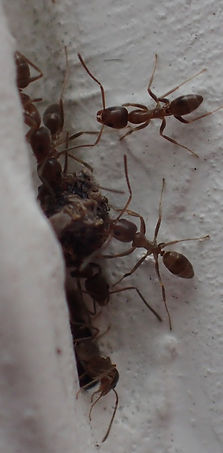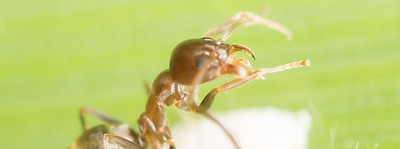Argentine Ants
These ants know no boundaries, and have great power in numbers.
What do Argentine Ants look like?
Argentine ants range in colour from light brown to black, and exhibit a glossy/shiny sheen. Worker ants typically measure between 2.2-2.8mm in length, while the queens size up to 4-6mm. They have a single node connecting the thorax to the abdomen, with a distinct, protruding bump at the petiole. Their antennas have 12 segments and are elbowed (bending part way through). When crushed, these ants emit a faint musty odour.

Where do they nest?
Argentine ants thrive in moist, wet environments close to a food source. They are commonly found in lush, damp areas like swamps or garden beds, often within urban settings. They nest around trees, under stones, and around buildings. When conditions become unfavourable they will relocate their nest, typically seeking refuge indoors during colder months. Inside homes, they prefer moisture-rich areas, often nesting near plumbing or in crawl spaces.
What do they eat?
These ants are attracted to sugary foods like plant nectar, honeydew, sweet beverages, syrup, and fruit juices. While they primarily forage for sweets, they also require protein-rich foods to maintain their diet. They will feed on pet food, eggs, meat, and even other insects.

What are the risks of having argentine ants?
Argentine ants are considered "tramp ants," which is a group of species that exhibit behaviours that make them challenging to manage. Tramp ants are known for being difficult to control due to their multi colony abilities. When left untreated Argentine ants continue creating new colonies, with the possibility of eventually becoming a super colony. At that point they become a huge challenge, which is why it is important to contact pest control professionals as soon as possible.
These ants do not just pose risks to households, but their impact extends globally. Argentine ants are a serious threat to native species, ecosystems, and biodiversity because they are an invasive species. These ants are native to North Argentina, Uruguay, Paraguay, Bolivia and southern Brazil but managed to infiltrate 6 out of 7 continents in world.


The Global Invasive Species Database ranked Argentine ants as #48 on the "100 if the World's Worst Invasive Alien Species" list.
why are Argentine ants such a powerful invasive species?
Argentine ants pose a significant threat due to their rapidly expanding population, aggressiveness toward other species, and ability to form massive super colonies. These ants do not exhibit hostility toward their own kind, which allows multiple colonies to cooperate and share resources with each other. They will take over food sources that other species rely on, resulting in displacement or even complete elimination of competing species.

Argentine ants overpowering another ant species
The Argentine ants have mastered the creation and maintenance of super colonies. Some of these colonies stretch an astonishing 700 to 1000 kilometers, which is comparable to traveling from Toronto to Montreal... twice! The largest known super colony spans 6,000 kilometers and is estimated to house millions, if not billions, of ants.

How to get rid of Argentine ants?
If you have noticed argentine ant activity inside or around your home, it is time to call in the pest control experts! Rural Routes Pest Control can provide control for the ant activity you are experiencing.
for more information about our ant control services.
